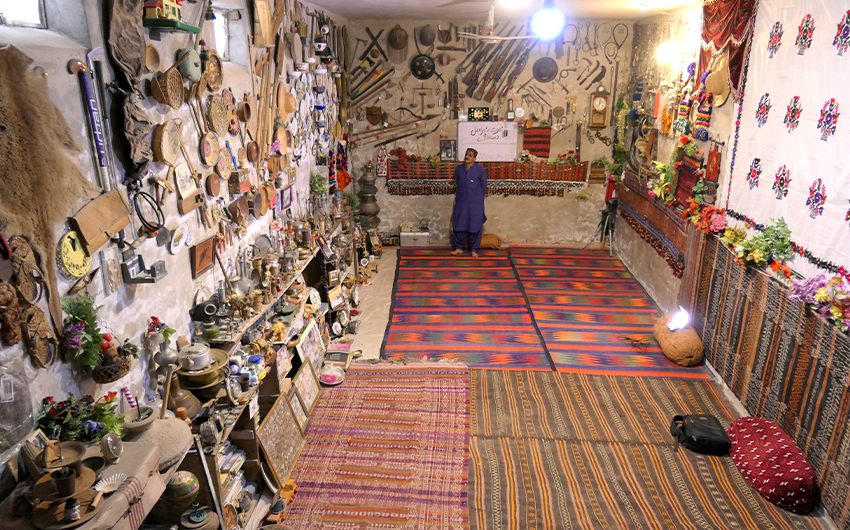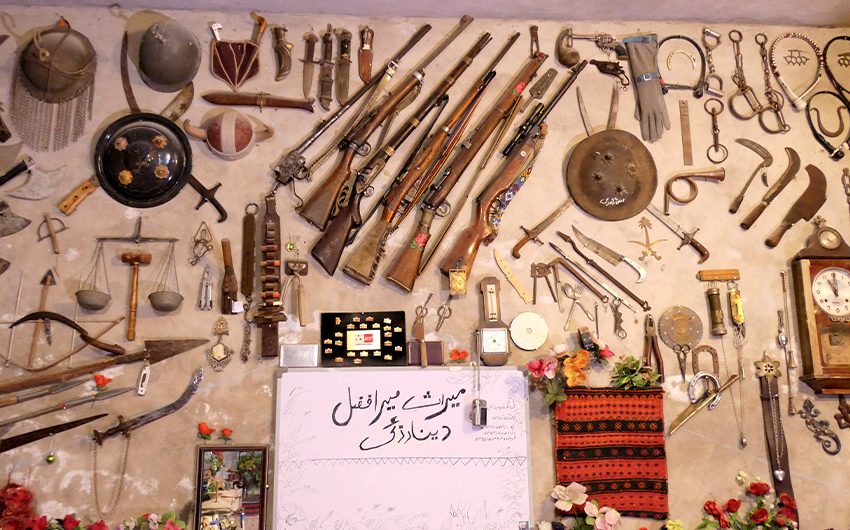QUETTA: In the basement of his home in southwestern Pakistan, one man’s beloved ‘museum’ is an ode to the brave legacy of Balochistan’s fabled wars.
Located in Quetta, the capital of Balochistan province, a vast collection of swords, rifles, shields and weapons used by Baloch tribes against British colonizers and before, is on display in a 35-ft basement room owned by Javed Bangulzai.
“I have adopted this passion of keeping and displaying antiques...used by Baloch tribes from my father, Muhammad Afzal Bangulzai, who was very fond of preserving the items and war equipment of our forefathers,” the 40-year-old said, while pointing to his favorite objects among dozens of swords, sabers, rifles, jewelry items and tools — some over 300 years old.

Javed Bangulzai in the basement he's converted into a war museum, inside his home in Quetta, Pakistan, on April 20, 2021. (AN Photo)
“In the whole museum my most favorite item is the Zagham sword which my great-grandfather had used during the Mashhad War in 1777,” he said.
“Alongside this is the Dhadhri rifle and Roghdar, another type of Balochi rifle, first used by Baloch warriors in Dhadhar district Kachi during the 1839 war when the British Army stormed the Khanate of Kalat.”
While Baloch tribes have been present in South Asia and part of the Middle East since before the Common Era, their own state, the Khanate of Kalat emerged in the region in the 16th century. Its people were famous for battle bravery. After the partition of India in 1947, the khanate remained a princely state until 1955, when it was incorporated into Pakistan.
For Bangulzai, keeping and studying Baloch heritage is a family affair. Most of the items belong to his ancestors, but some, he said, were gifted by friends who believed the museum was the perfect place to keep them.

Ancient swords, guns and other war artifacts hang on the wall in Javed Bangulzai’s home in Quetta, Pakistan on April 20, 2021. (AN Photo)
Baloch tribes had advanced weaponry as they were continuously engaged in warfare — against others and among themselves — historian Panah Baloch told Arab News.
“Baloch warriors, with their sharp war skills and bravery remained allies and supported many other tribes and nations who waged wars to free or expand their land. The Balochs have even stood with famous Afghan ruler Ahmad Shah Abdadli who fought to expand his land toward the Persian subcontinent during the 16th century,” he said.
“They made many types of swords like the Sheerazi sword during the Rind and Lashar tribes war in the 16th century and Hindi swords during the war with the British Army.”
The Quetta home museum regularly receives visitors who are guided through the collection and Baloch history by Bangulzai and his younger brothers.
“I spend almost all of my days inside my home museum in order to absorb the whole history of my family,” Bangulzai said, with his hands crossed behind his back, proudly perusing his collection as though for the first time.
“Seeing these swords and rifles... reminds me of their bravery.”
















